Objective: Warsaw (Quick and dirty demo AAR)
- Thread starter Lordban
- Start date
-
We have updated our Community Code of Conduct. Please read through the new rules for the forum that are an integral part of Paradox Interactive’s User Agreement.
You are using an out of date browser. It may not display this or other websites correctly.
You should upgrade or use an alternative browser.
You should upgrade or use an alternative browser.
Thank you so much for this AAR. As a newbie (I own HOI II but I didn't get to play it much) I was nearly ready to shelve HOI III after playing the demo, but it all starts to make sense now. Your AAR together with the strategy guide will probably enable me to understand what is going on and what to do. And motivate me to hang in there long enough to do so. 
I wish there were more tutorial AARs.
(Oh, and Paradox: I've played many, many games in my life and the tutorial for HOI III is the worst I have ever seen. Completely void of information. Horrible.)
I wish there were more tutorial AARs.
(Oh, and Paradox: I've played many, many games in my life and the tutorial for HOI III is the worst I have ever seen. Completely void of information. Horrible.)
Excellent AAR, thanks! 
I'm learning a lot while waiting my preordered HOI3.
*back to reading HOI3's manual*
I'm learning a lot while waiting my preordered HOI3.
*back to reading HOI3's manual*
That was a truly exception AAR for rookies. I have always struggled with PI games. Just how to get started, etc.... That one was decidedly helpful in that regard.
Woo! French offensives in the Rhineland, British invasions in northern Germany... It might not be what happened historically, but it does seem to suggest the AI will be far less predictable.
Nice job hammering the British invasion fleet. I notice there are German forces gathering next to the Kiel pocket, so it should be very interesting to see if the AI can destroy them without further prompting.
Nice job hammering the British invasion fleet. I notice there are German forces gathering next to the Kiel pocket, so it should be very interesting to see if the AI can destroy them without further prompting.
Myth, if only I could get to their REAL ships 
Enewald, I don't want to imagine what it'll be like!
coz1, thanks! And yes, it was quite sneaky of them, but let 'em come, we are Germany, we fear no one on the land!
De Savage, Javaslinger, Todd Hawks, Jorath13, you're welcome!
And yes, the tutorial was mildly amusing, but it only showed you around part of the interface and failed to show how things actually worked. Maybe PI can expand on what they've done (with other leaders to guide you, obviously) and make several more tutorials which actually get down to business.
Stuyvesant, it may not be historical, but it's interesting! There were some limited French offensives in the Saarland resulting in an advance of some 10 kilometres - and a subsequent withdrawal - and seeing no attempt at attacks even with a nearly empty border seemed a little odd. We certainly aren't going to see this any longer!
**
XV. The Longest Week
The first week of the war draws to a close, and we've already drawn a number of lessons from them.
Since we were talking about Naval issues, here's a list of the ships sunk in this first week of action:
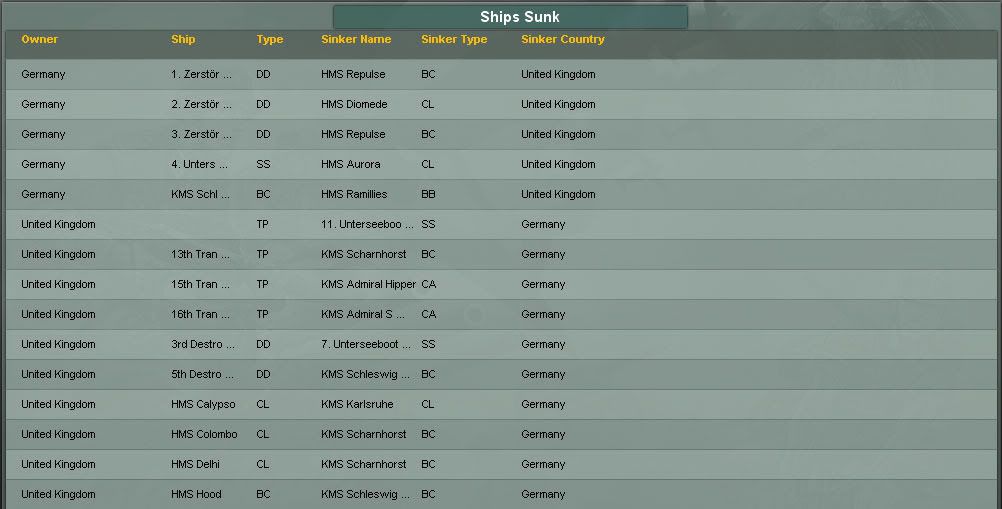
This ledger looks nice - in fact it could have been much worse, seeing how our first encounter with the Royal Navy ended. Still, let's not fool ourselves: we're going nowhere at this rate - we won't even manage to secure the Baltic or the Danish straits, our encounter with British BBs showed that clearly enough. Aside from HMS Hood, the British haven't lost any significant ship, and they've got nearly ten times as many of them as we do.
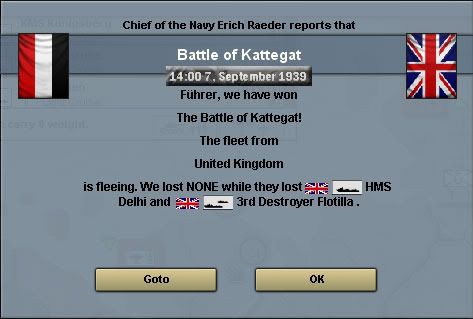
The decision to send Böhm on a short pursuit was the right one. We also put HMS Fröbisher out of action for a while, it barely escaped the battle.
Böhm is now rebasing to Rostock.
On to the air war. Here the situation looks a bit depressing: Poland and France combined line up far more planes than we can, and there's always the presence of the odd British STRAT bomber. Results look unimpressive taken as they are - like Ground Attacks averaging 60 men killed and 0.3% ORG loss, or unescorted bomber wings hardly taking damage in an engagement with fighter planes but on a closer look, some things are happening:
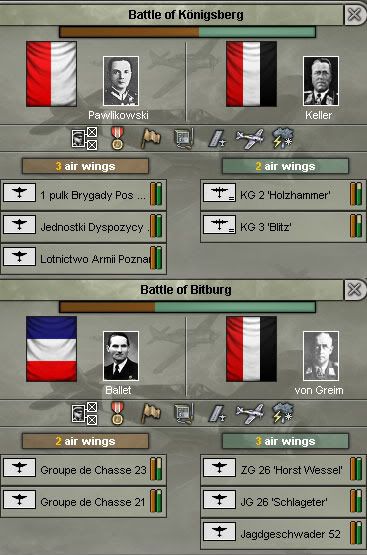
Keller's air wing is the one in the best shape on the Polish front. The other two are around half ORG, with some squadrons far below that value. Here the Polish superiority in fighters is starting to tell.
We could have redeployed all our fighter planes to the Polish front, leaving the French front unprotected from air attacks, but here too, in spite of overall inferiority - 6:5 advantage for the French - things are happening. The first of them is the French have grouped 4 INTs with 2 TACs, always seen together and dogfought on a regular basis. This wing size is rather inefficient, and even though they inflict damage, they also receive their fair share.
The other two INT wings are engaged in regular challenges for Air superiority with our own INTs, and here too it starts to show. We're gradually exhausting the French air forces just with what we have at the moment; now all we really need to do is rest our planes after the fall of Poland while the forces already present on the theatre keep inflicting low-level damage on the French, and should we decide to attack them, they will be overwhelmed with fresh air wings. This is the reason why we won't change our present air deployment, even though it's somewhat damaging for us in Poland.
And since we're talking about Poland...
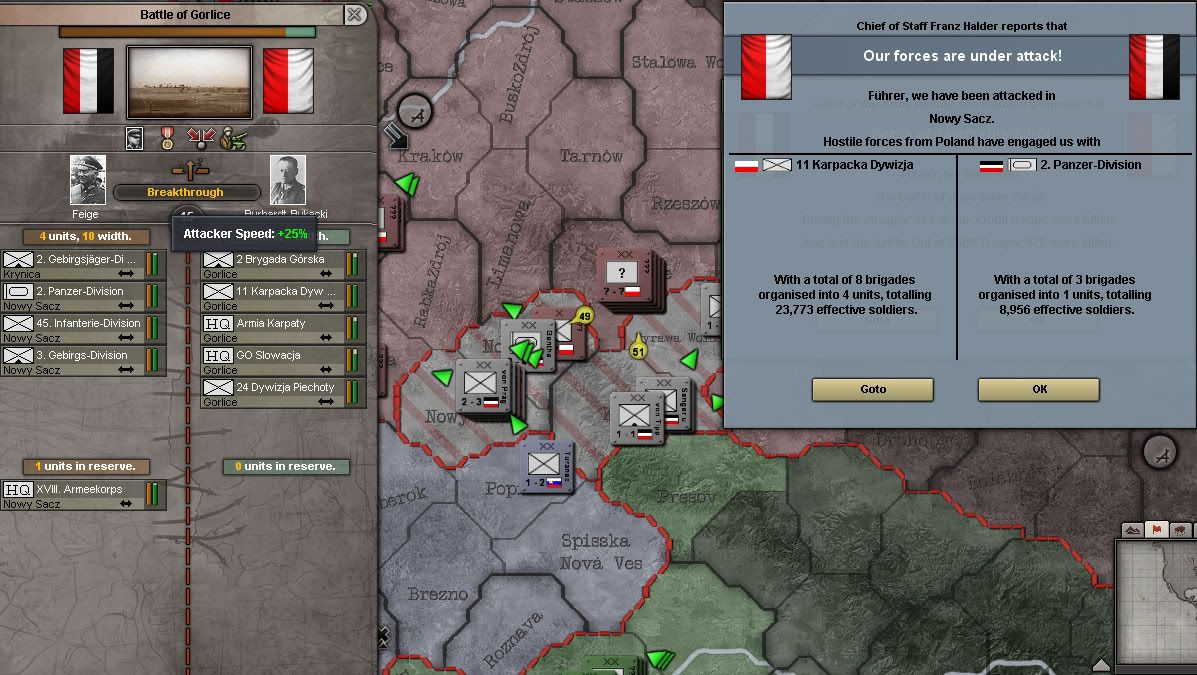
The Poles have actually launched a powerful counterattack against one of our spearheads.
Unfortunately for them, it was nowhere near powerful enough to knock it out before reinforcements arrived; those reinforcements, as well as 2. Panzer-Division, are also attacking them in Gorlice, reinforced by a Mountain division attacking the Poles on their left.
This is an interesting development: both our and the Polish forces were given conflicting sets of orders, each force trying to dislodge the other from its current position.
The result: both forces are involved in two simultaneous battles, as attackers in one and defenders in the other - with the corresponding penalties for flanking attacks. This means both battles move faster than other similar ones, and it's no good news for the Poles as we enjoy the advantage and are capable of exploiting it faster than if they had simply been defending.
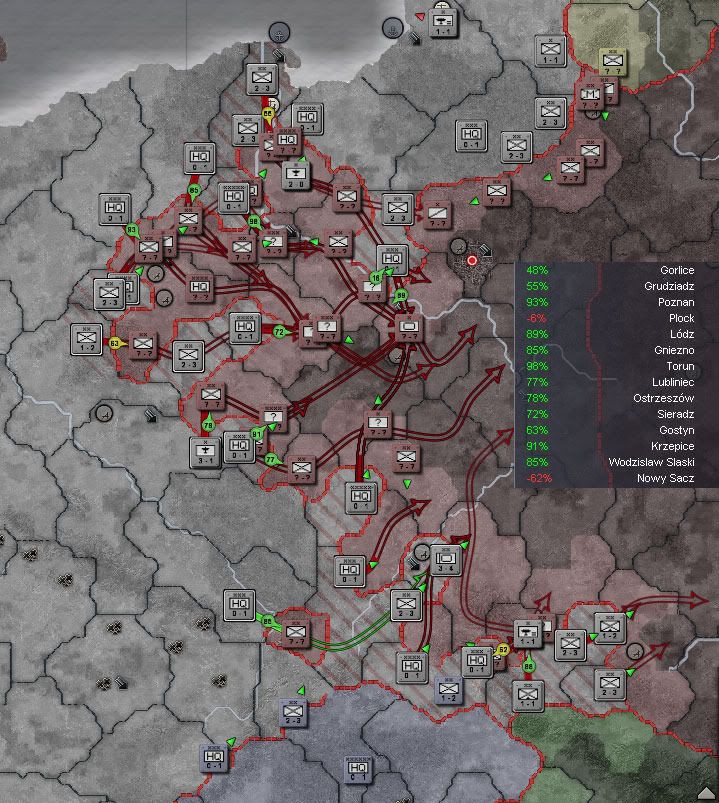
This is our progress after a week of fighting.
As you can see, the southern part of the front has already collapsed, and aside from a few pockets of resistance like the one in Gorlice, there is little to prevent us from exploiting our strategic breakthrough. Kraków has fallen without a fight - we are about to redeploy our air forces there - and Lwów is threatened.
In the northern part of the front, the higher density of troops and the counterattack at Plock prevented us from bagging a half of the Polish army. However, a lot of their forces have already been defeated in detail, we have managed several local breakthroughs, and the Polish forces are being fragmented into small units.
The Western forces may not be encircled, they are certainly enveloped, and this has started to cause them some troubles.
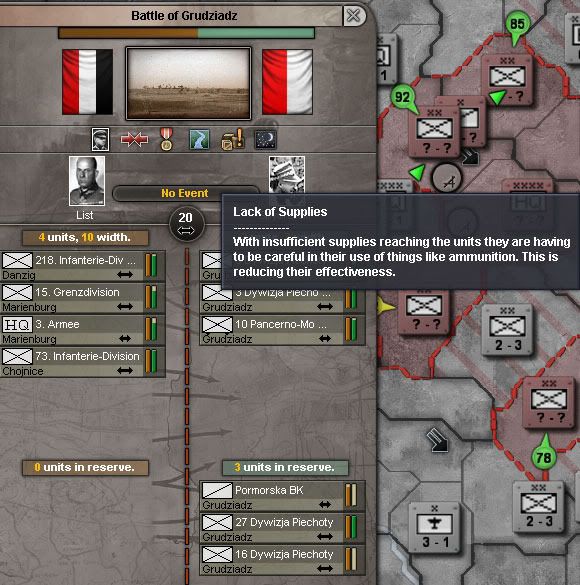
This is what you sse in a good number of battles of the northern part of the Polish front: alerts indicating some units lack supplies. And since it isn't the case of ours, it can only be the Polish.
Their supply troubles are a direct result of our advances in their rear; we have cut some supply lines, and it takes some time before new ones are established.
None of the Polish units have actually run out of supplies - they are living off the ones divisions carry with them, and aren't yet facing penalties for lack of supplies. Still, we're already being informed they are in some trouble.
All in all, in spite of local setbacks, it seems we are on the schedule for our offensive.
Enewald, I don't want to imagine what it'll be like!
coz1, thanks! And yes, it was quite sneaky of them, but let 'em come, we are Germany, we fear no one on the land!
De Savage, Javaslinger, Todd Hawks, Jorath13, you're welcome!
And yes, the tutorial was mildly amusing, but it only showed you around part of the interface and failed to show how things actually worked. Maybe PI can expand on what they've done (with other leaders to guide you, obviously) and make several more tutorials which actually get down to business.
Stuyvesant, it may not be historical, but it's interesting! There were some limited French offensives in the Saarland resulting in an advance of some 10 kilometres - and a subsequent withdrawal - and seeing no attempt at attacks even with a nearly empty border seemed a little odd. We certainly aren't going to see this any longer!
**
XV. The Longest Week
The first week of the war draws to a close, and we've already drawn a number of lessons from them.
Since we were talking about Naval issues, here's a list of the ships sunk in this first week of action:

This ledger looks nice - in fact it could have been much worse, seeing how our first encounter with the Royal Navy ended. Still, let's not fool ourselves: we're going nowhere at this rate - we won't even manage to secure the Baltic or the Danish straits, our encounter with British BBs showed that clearly enough. Aside from HMS Hood, the British haven't lost any significant ship, and they've got nearly ten times as many of them as we do.

The decision to send Böhm on a short pursuit was the right one. We also put HMS Fröbisher out of action for a while, it barely escaped the battle.
Böhm is now rebasing to Rostock.
On to the air war. Here the situation looks a bit depressing: Poland and France combined line up far more planes than we can, and there's always the presence of the odd British STRAT bomber. Results look unimpressive taken as they are - like Ground Attacks averaging 60 men killed and 0.3% ORG loss, or unescorted bomber wings hardly taking damage in an engagement with fighter planes but on a closer look, some things are happening:

Keller's air wing is the one in the best shape on the Polish front. The other two are around half ORG, with some squadrons far below that value. Here the Polish superiority in fighters is starting to tell.
We could have redeployed all our fighter planes to the Polish front, leaving the French front unprotected from air attacks, but here too, in spite of overall inferiority - 6:5 advantage for the French - things are happening. The first of them is the French have grouped 4 INTs with 2 TACs, always seen together and dogfought on a regular basis. This wing size is rather inefficient, and even though they inflict damage, they also receive their fair share.
The other two INT wings are engaged in regular challenges for Air superiority with our own INTs, and here too it starts to show. We're gradually exhausting the French air forces just with what we have at the moment; now all we really need to do is rest our planes after the fall of Poland while the forces already present on the theatre keep inflicting low-level damage on the French, and should we decide to attack them, they will be overwhelmed with fresh air wings. This is the reason why we won't change our present air deployment, even though it's somewhat damaging for us in Poland.
And since we're talking about Poland...

The Poles have actually launched a powerful counterattack against one of our spearheads.
Unfortunately for them, it was nowhere near powerful enough to knock it out before reinforcements arrived; those reinforcements, as well as 2. Panzer-Division, are also attacking them in Gorlice, reinforced by a Mountain division attacking the Poles on their left.
This is an interesting development: both our and the Polish forces were given conflicting sets of orders, each force trying to dislodge the other from its current position.
The result: both forces are involved in two simultaneous battles, as attackers in one and defenders in the other - with the corresponding penalties for flanking attacks. This means both battles move faster than other similar ones, and it's no good news for the Poles as we enjoy the advantage and are capable of exploiting it faster than if they had simply been defending.

This is our progress after a week of fighting.
As you can see, the southern part of the front has already collapsed, and aside from a few pockets of resistance like the one in Gorlice, there is little to prevent us from exploiting our strategic breakthrough. Kraków has fallen without a fight - we are about to redeploy our air forces there - and Lwów is threatened.
In the northern part of the front, the higher density of troops and the counterattack at Plock prevented us from bagging a half of the Polish army. However, a lot of their forces have already been defeated in detail, we have managed several local breakthroughs, and the Polish forces are being fragmented into small units.
The Western forces may not be encircled, they are certainly enveloped, and this has started to cause them some troubles.

This is what you sse in a good number of battles of the northern part of the Polish front: alerts indicating some units lack supplies. And since it isn't the case of ours, it can only be the Polish.
Their supply troubles are a direct result of our advances in their rear; we have cut some supply lines, and it takes some time before new ones are established.
None of the Polish units have actually run out of supplies - they are living off the ones divisions carry with them, and aren't yet facing penalties for lack of supplies. Still, we're already being informed they are in some trouble.
All in all, in spite of local setbacks, it seems we are on the schedule for our offensive.
Hmm, that's quite realistic.
Btw, after the unit is encircled, for a how long time do the supplies it has there in the province where it is located last?
Btw, after the unit is encircled, for a how long time do the supplies it has there in the province where it is located last?
Ahh, that's why I went after the sweeping movement from Silesia and Slovakia--the Polish line there was quite thin, as you've seen yourself. 
Ahh, that's why I went after the sweeping movement from Silesia and Slovakia--the Polish line there was quite thin, as you've seen yourself.
I think the poles were quite sure of the possibility that Hitler would want only the corridor back and most of the important fighting was to occur there.
Little did they think of being overrun in less than a month.
Or that panzers were to surround and destroy most of the troops on the borders, everywhere.
alerts indicating some units lack supplies. And since it isn't the case of ours, it can only be the Polish.
Ah this is a question I've been meaning to ask. Why isn't there any indication as to which army is facing these penalties? Is it an GUI oversight or is it by design? I find it odd that you have to figure it out yourself.
Very nice. The Polish supply situation (temporarily disrupted until a new route can be set up) seems indicative of the game's newfound complexity: there's a lot more that needs to be taken into account, but the end result is a more believable simulation of the war.
Meanwhile, it's hard to believe that only a week in your game has passed, with all the updates we've had!
Meanwhile, it's hard to believe that only a week in your game has passed, with all the updates we've had!
Awwww, that is pwetty 
And speaking of supplies- don't brits need to convoy some supplies in as well? Now is a good time to make every boat that is bigger then bathtub to convoy raid the Danish straights and show these brits that it's tough to fight wihtout fuel and ammo. I hope this works at least
And speaking of supplies- don't brits need to convoy some supplies in as well? Now is a good time to make every boat that is bigger then bathtub to convoy raid the Danish straights and show these brits that it's tough to fight wihtout fuel and ammo. I hope this works at least
Enewald, indeed, this game feels a lot more realistic than HoI2 did upon release. This time I won't be surprised with the first GER '36 game turning into a WC.
Myth, thin indeed Still, sticking to a plan close to history has been rather interesting.
Still, sticking to a plan close to history has been rather interesting.
Tweakd, it was indeed a little odd to let the cursor hover every single unit and not see any problems.
Stuyvesant, new routes were set up on Sept. 8 and everything went back to normal.
Only a week, and 15 posts already - in the space of 25 hours :wacko:
hjarg, touché! We'll be talking about those supply convoys to Kiel in a moment.
We'll be talking about those supply convoys to Kiel in a moment.
**
XVI. From bad to worse
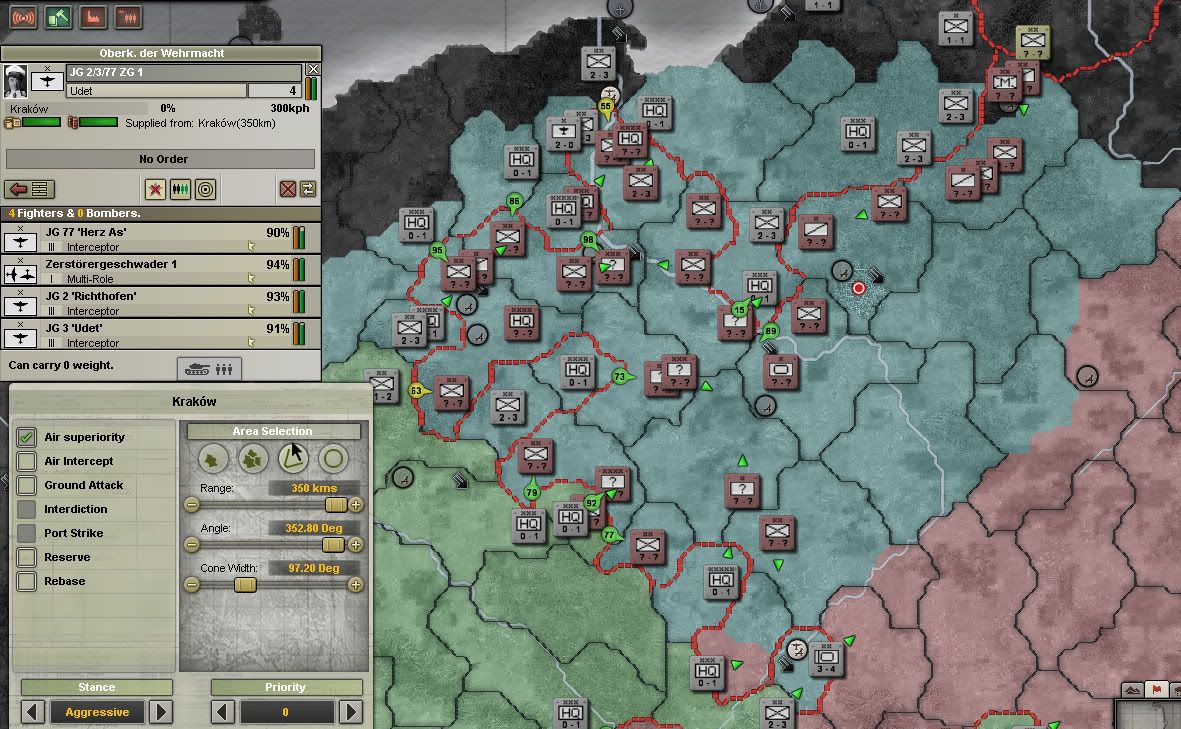
We redeploy our largest fighter wing to provide some air superiority over the Polish countryside.

They set upon their tasks immediately - and set about wreaking havoc on the Polish forces based in Warsaw. Each of those eight squadrons get a -70% stacking penalty - they're as effective as a total of 2.4 squadrons, as opposed to our 2.8 ratio. AND there are TACs among them.
Looks like we're finally going to hit the Polish airforce pretty hard.
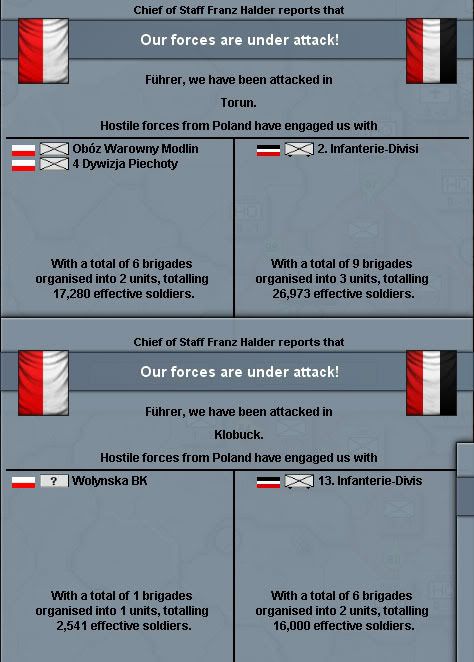
The Poles are throwing more counterattacks of their own, but some of them aren't exactly frightening. Looks like they're starting to feel pretty desperate...

... which they should, honestly. A good third of their army is about to be split into three small pockets, and they aren't getting out anytime soon.

In the West, nothing new.
Unfortunately this attack looks poised to succeed; fortunately, there are more than enough troops on this part of the front to contain the French. We are in no danger of breakthrough, and will have time later to clean up the mess.
No, the only danger seems to lay in Kiel...

... and the AI is already doing something about it.
We're keeping Böhm's fleet tucked in Rostock harbor instead of hunting convoys for a simple reason: we want it ready to intervene if we spot another small British fleet, and don't want to expose it to a possible attack by a large RN unit.
**
There's a nasty storm brewing near my home - it isn't guaranteed my PC will get power to keep running throughout the night. Unfortunately, with the lack of a Save feature, this means this AAR could be brought to a quick, brutal end by the forces of nature
EDIT - Going offline anyways. Good night to you all!
Myth, thin indeed
Tweakd, it was indeed a little odd to let the cursor hover every single unit and not see any problems.
Stuyvesant, new routes were set up on Sept. 8 and everything went back to normal.
Only a week, and 15 posts already - in the space of 25 hours :wacko:
hjarg, touché!
**
XVI. From bad to worse

We redeploy our largest fighter wing to provide some air superiority over the Polish countryside.

They set upon their tasks immediately - and set about wreaking havoc on the Polish forces based in Warsaw. Each of those eight squadrons get a -70% stacking penalty - they're as effective as a total of 2.4 squadrons, as opposed to our 2.8 ratio. AND there are TACs among them.
Looks like we're finally going to hit the Polish airforce pretty hard.

The Poles are throwing more counterattacks of their own, but some of them aren't exactly frightening. Looks like they're starting to feel pretty desperate...

... which they should, honestly. A good third of their army is about to be split into three small pockets, and they aren't getting out anytime soon.

In the West, nothing new.
Unfortunately this attack looks poised to succeed; fortunately, there are more than enough troops on this part of the front to contain the French. We are in no danger of breakthrough, and will have time later to clean up the mess.
No, the only danger seems to lay in Kiel...

... and the AI is already doing something about it.
We're keeping Böhm's fleet tucked in Rostock harbor instead of hunting convoys for a simple reason: we want it ready to intervene if we spot another small British fleet, and don't want to expose it to a possible attack by a large RN unit.
**
There's a nasty storm brewing near my home - it isn't guaranteed my PC will get power to keep running throughout the night. Unfortunately, with the lack of a Save feature, this means this AAR could be brought to a quick, brutal end by the forces of nature
EDIT - Going offline anyways. Good night to you all!
Last edited:
That storm is more worrying than all the Allied actions in your AAR combined. Let's hope the game survives intact! 
I know how that is! Hopefully everything goes well. Quite interesting still, I'm thinking of trying out some of these strategies tomorrow.Lordban said:There's a nasty storm brewing near my home - it isn't guaranteed my PC will get power to keep running throughout the night. Unfortunately, with the lack of a Save feature, this means this AAR could be brought to a quick, brutal end by the forces of nature

